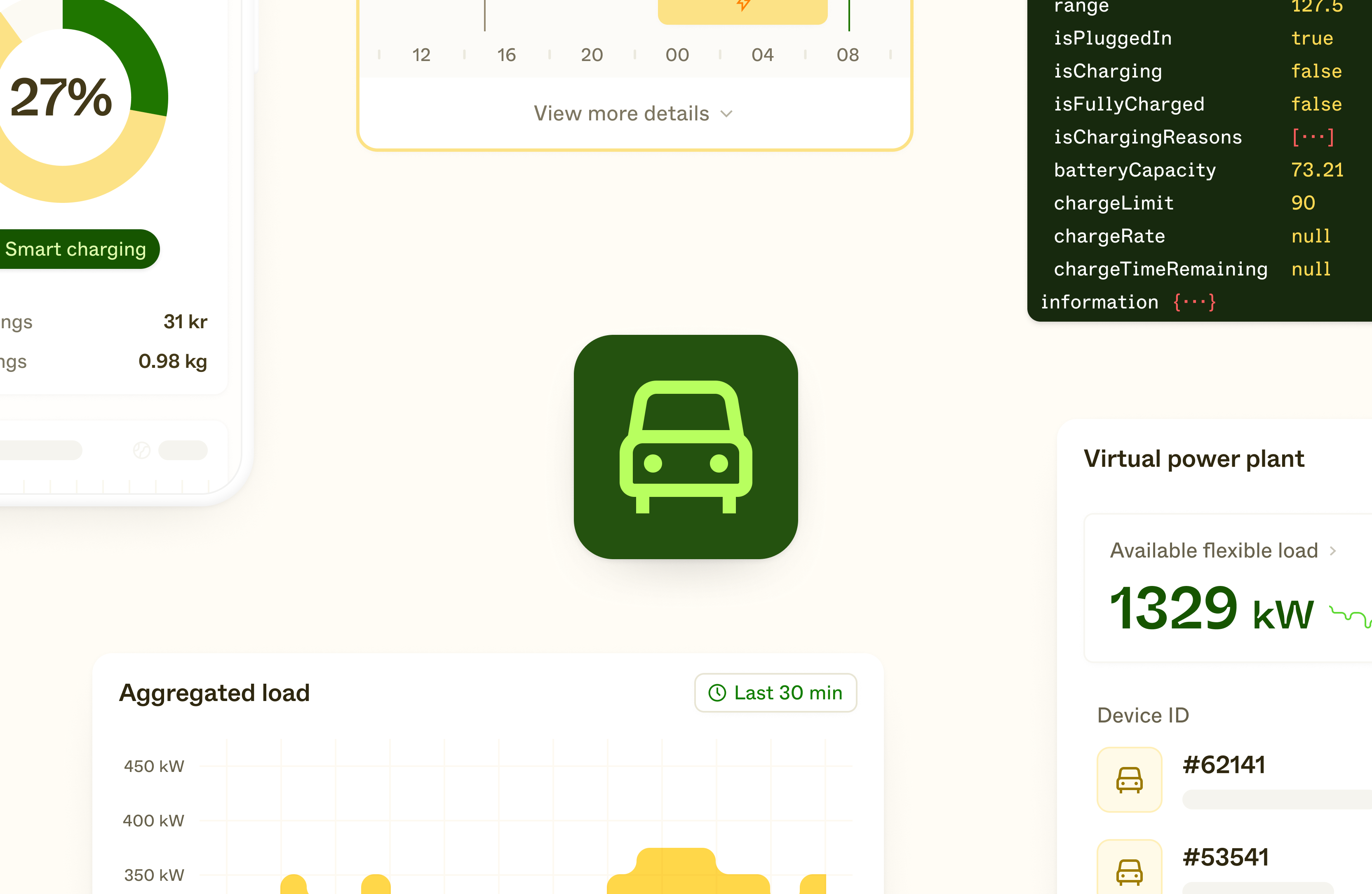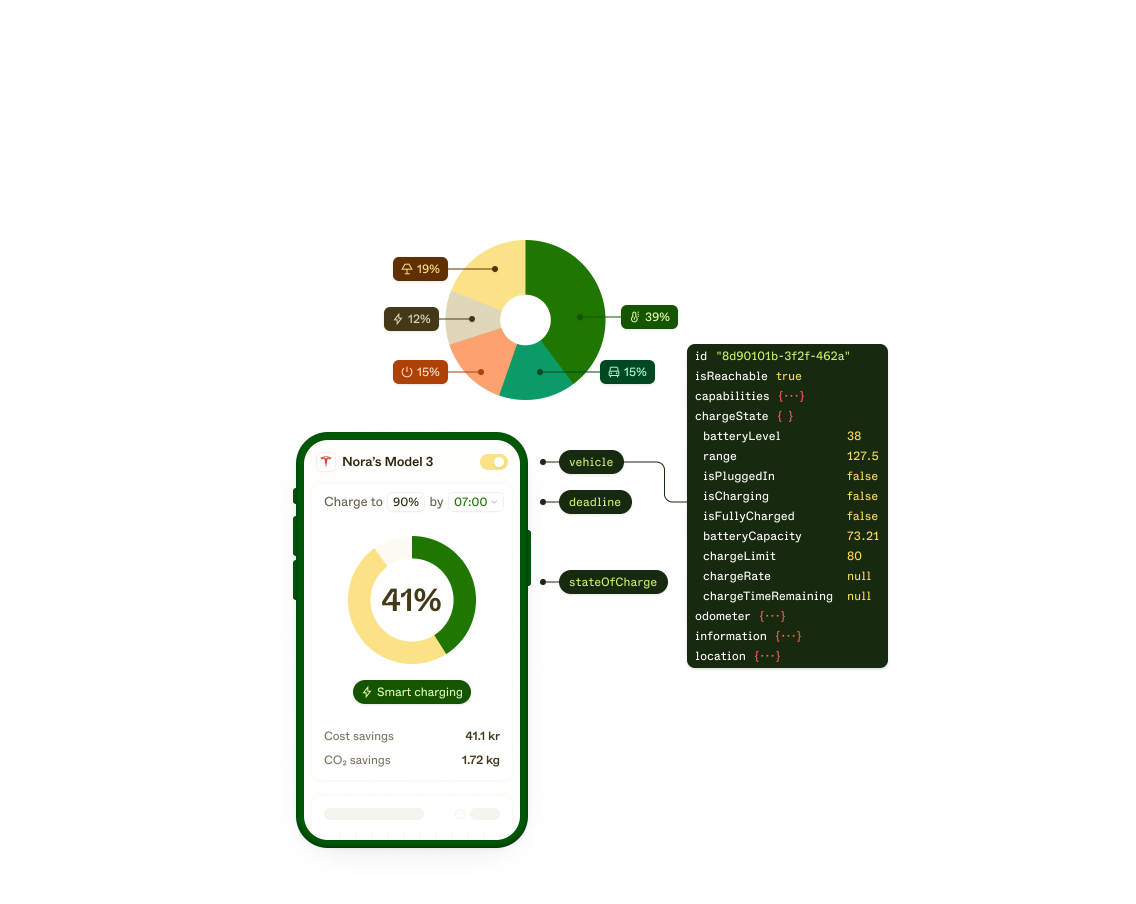The ultimate guide to Vehicle-to-Grid (V2G)

Our energy system is changing. In the last few years, consumers have become more educated about – and engaged with – their energy consumption and its impact. Now, innovative technologies are coming to market to help them manage it more effectively.
One of the most ground-breaking is Vehicle-to-Grid (V2G) technology. V2G technology turns electric vehicles (EVs) into mobile energy storage units that can store and redistribute energy back to the electricity grid in times of high demand. V2G is a critical enabler of a more sustainable energy system – and it drives real value for energy retailers and consumers, too.
V2G is just about to hit the mainstream. It’s guaranteed to revolutionize the way we generate, distribute and consume energy, helping cut carbon emissions, reduce consumer energy bills, and unlock new avenues for sustainable growth.
But what exactly is V2G? How does it work? And how can Product Managers leverage it to build use cases customers care about? This comprehensive guide tells you all you need to know:
- What is Vehicle-to-Grid?
- What is the role of EVs in balancing the grid?
- How does Vehicle-to-Grid technology work?
- What are the core components of Vehicle-to-Grid?
- What is the role of software in Vehicle-to-Grid?
- What use cases can Product Managers build on top of Vehicle-to-Grid technology?
- What are the benefits of Vehicle-to-Grid?
What is Vehicle-to-Grid (V2G) technology?
Vehicle-to-Grid technology enables electricity to flow bidirectionally between EVs and the electricity grid.
Let’s put that in simpler terms. Typically, electricity only flows in one direction: it’s transmitted from the grid to the energy devices (including everything from factories to homes, EVs, and even kettles) that consume it. V2G technology enables that flow of electricity to go back the other way as well – from EVs to the grid.
EVs have large batteries, and can store significant amounts of electricity. They’re also equipped with small computers that enable us to communicate with and program them. So, we can program V2G-enabled EVs to store surplus electricity at times of high supply and low demand, and discharge it back to the grid at times of high demand and low supply.
What is the role of EVs in balancing the grid?
EVs have an important role to play in balancing the grid. Our grid is under a lot of pressure. Demand for electricity is growing, especially as more EVs (which require a lot of electricity to run) hit the roads. It’s getting harder and harder to balance demand and supply, and that puts us at risk of blackouts and outages.
There are two possible solutions to this. One is to increase supply. Because renewable energy generation is intermittent, we would most likely have to rely (at least in part) on fossil fuels to make up the shortfall. That slows down our transition to a more sustainable, renewables-powered energy system. The other solution is to reduce demand. This is where EVs become such a valuable asset.
With V2G technology, we can turn EVs into mobile energy storage units. Bidirectional chargers allow the EVs to store surplus electricity during periods of high renewable energy generation, and discharge stored energy when renewable energy availability is low. This makes EVs an effective energy resource for balancing demand and supply, and an important part of our transition to a more sustainable energy system.
How does Vehicle-to-Grid technology work?
Vehicle-to-Grid technology continuously calculates and analyzes a wide range of variables to identify when to charge and discharge the EV. This includes live vehicle data, live electricity market data, and customer preferences.
When the EV is plugged in and charging, the V2G technology monitors grid conditions, and adjusts the charging rates of the EV accordingly. If there’s lots of supply in the grid, the EV can be set to charge fully. But if it’s a period of high demand and the grid needs additional power, the EV can be programmed to discharge some or all of its stored energy. This all happens automatically, without customers having to make any effort.
Of course, customers have to give their consent to participate in V2G programs, and those that do are compensated for the energy their EV supplies black to the grid. Usually, energy retailers or V2G service providers calculate how much energy was exchanged, and the agreed rate for that energy. Then, customers are compensated in the form of credits, reduced energy bills, or even direct payments. It depends on the structure of the program they’ve signed up to.
What are the core components of Vehicle-to-Grid technology?
There are few core components that Product Managers need in order to enable V2G programs in their apps:
- EVs: First (and most obvious) is electric vehicles. EVs must be equipped with V2G capability to be eligible. Not all EVs have this capability.
- Charging infrastructure: Smart chargers enable the seamless exchange of energy between EVs and the grid. These chargers make bidirectional charging possible, so that energy can be drawn from the EV and supplied back to the grid based on demand and user preference.
- APIs: APIs (Application Programming Interfaces) establish a connection between EVs, chargers and the grid, and allow for the exchange of data between them. They enable real-time monitoring of conditions inside the EV and the grid, so that energy consumption can be automatically managed and optimized.
What is the role of software in Vehicle-to-Grid technology?
As you can see, software – and particularly APIs – has a critical role to play in the implementation and operation of V2G systems. V2G relies on a lot of real-time data from the energy market and from EVs in order to work effectively. The V2G system needs live information about the EV battery capacity and the level of demand in the grid in order to determine when to charge and discharge. APIs act as a bridge between all the different components involved in V2G, enabling real-time communication, data exchange, and control.
APIs make it easy to:
- Share data: APIs automatically collect and distribute various data points in real time, like EV battery health, charging patterns, grid conditions, and energy pricing. APIs also enable the sharing of data with EV owners, allowing them to track their energy usage, costs, and environmental impact, usually through an energy management or EV app.
- Send commands: APIs can also trigger actions automatically, like telling the EV to stop or start charging. By managing charging schedules, they can help optimize energy flows to and from the grid, and balance the grid’s load.
- Build new use cases: APIs enable seamless integration and interoperability across the energy ecosystem. That makes it much quicker and easier for energy retailers to build applications, services, and products on top of the V2G infrastructure.
What use cases can energy retailers build with Vehicle-to-Grid technology?
So, what exactly can Product Managers build with V2G technology? V2G promises to unlock a range of innovative services in the future, but today, a few key use cases are taking center stage:
- Virtual Power Plants: V2G-enabled EV fleets can be aggregated to form virtual power plants (VPPs). VPPS leverage cloud software to group together the battery capacity in small-scale energy devices like EVs. They can then be used to store excess energy at scale, and redistribute it when the grid’s under pressure. VPPs provide grid stability and supplementary power during peak demand periods.
- Demand Response: V2G technology also helps energy retailers to efficiently balance load within their network. Demand Response involves reducing or shifting electricity consumption at peak times in order to balance the grid. Connecting to EVs and other residential energy devices means they can respond automatically to signals from the grid. It means EVs can be programmed to stop charging when demand is high, and start again when demand is low, while ensuring that they’re fully charged by a set deadline.
- Energy Storage and Resilience: V2G-enabled EVs can serve as decentralized energy storage systems, contributing to grid resilience during power outages or emergencies. Product managers can develop backup power solutions that rely on EVs to provide critical electricity supply during downtime. One example is solar smart charging, where users can schedule their EV to charge at times of surplus locally-generated solar energy. Instead of excess solar energy being sold back to the grid, it can be automatically diverted to start charging customers’ EVs.
What are the benefits of V2G?
Vehicle-to-Grid technology is incredibly beneficial for energy customers, energy retailers, and the environment. Three of the major benefits V2G drives are:
- Reducing Carbon Emissions: V2G technology plays a crucial role in the transition towards cleaner, greener energy solutions. V2G unlocks the power of EVs, and enables energy retailers to deploy them as distributed energy resources (DERs). Tapping into this sustainable and renewable energy source significantly reduces greenhouse gas emissions, especially as uptake of EVs continues to grow. By electrifying transportation and reducing reliance on fossil fuels in the energy system, we’ll make significant progress towards our ambitious climate goals.
- Lowering Consumer Energy Bills: V2G technology essentially allows EV owners to turn their vehicles into mobile power banks. That makes them money. During periods of peak electricity demand, EV owners can sell excess energy from their vehicles back to the grid. This not only offsets their energy costs, but creates new revenue streams, too.
- Creating better customer experiences: The energy market is evolving, and energy retailers need to find new revenue streams and new ways to engage customers in order to stay relevant. Energy retailers can leverage V2G technology to create differentiated use cases that help EV drivers get more value from their vehicles. As customers become more environmentally conscious, and the number of EV drivers grows, the ability to offer innovative energy services will help energy retailers win and retain market share.
For energy retailers seeking innovative solutions to drive sustainability and win customer share, V2G is a game-changer. By leveraging the bidirectional flow of energy between electric vehicles and the power grid, energy retailers can reduce carbon emissions, empower consumers, and unlock new possibilities for sustainable growth. As a Product Manager, understanding the benefits and capabilities of V2G technology puts you at the forefront of the energy revolution.
Ready to build a cleaner, smarter, and more efficient future? Get in touch and learn how to start building with V2G technology.
